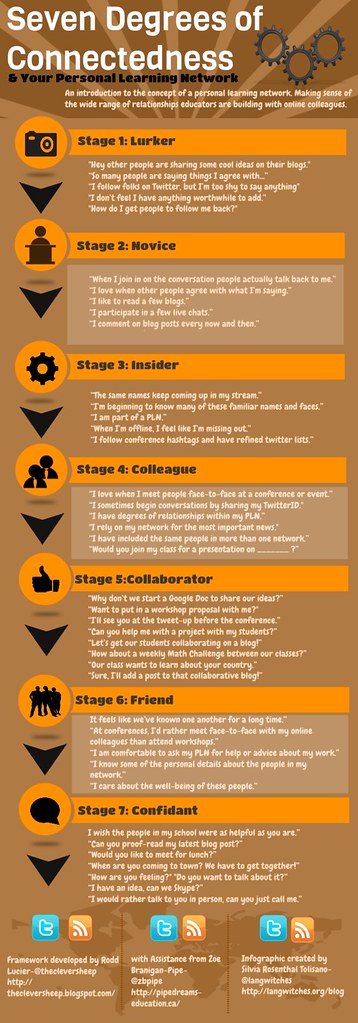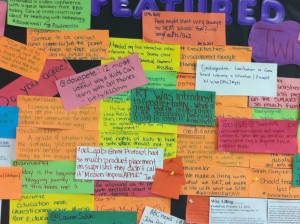Look at the “Seven Degrees of Connectedness” and think about how you nurture, support, and develop relationships on line, professionally and even personally. Do you have a close circle, a clique, a group of educators that you depend on – those in Stage 6 or 7? Do you have colleagues that work in your school, your district, your city – that you empower or that empower you? Do you have their back when they mess up, or need a pat on the shoulder, or need a word of praise here and there? Do you have the strength to DM them a concern? What would you do if you noticed they made an offensive remark? Are you prepared to have that “difficult conversation”? Do you do it in private? In public? Do you Unfollow them? DM them?
For many of us, Social Networking has changed the way we work, relate, share, create and learn. Just think, throughout history, innovators have created so many different avenues and channels to share and communicate and strengthen relationships at many levels – some very surface and others very intense and deep – even life changing. What about the printing press? The mail system? The phone, radio, television? In so many ways, the transparent nature of all of these tools makes us all so vulnerable, which is why we depend on our relationships and our trust in others to help us do the right thing and be the best we can be. We want to encourage risk taking so it will lead to new innovations, new thinking, new perspectives. But, with each of these channels comes a risk. Risk of error, risk of misinformation, risk of misinterpretation, risk of bias, risk of judgement. Even risk of friendship or something deeper.
Online tools, like Twitter or Facebook also pose a risk. We know this. Have you ever said something “in the heat of the moment?” that should have been kept private?Have you ever deleted a Tweet?
Sometimes we are just learning, and along the way, we make mistakes. When I first started on Twitter, about four years ago, I had no idea that I was “Tweeting” with location settings “ON” until @dougpete sent me a friendly DM suggesting that I take it off since he could see exactly where I live. Not a good idea. Another time I tweeted out comment that wasn’t all that appropriate during a live debate (political) and again, received a DM from an online colleague who simply reminded me “Zoe…you have a very public audience here”. Once, I even Tweeted out my home phone number in the public stream, instead of the intended DM. Again, an online colleague, one whose relationship and trust was built over time, sent me a little note, “Zoe, delete the last tweet”.
Whatever the channel or method, face-to-Face or online, the way we nurture and respond to relationships depends on the level of trust we have. Even in a public stream like twitter, there will always be a circle of colleagues and friends (STAGE 7) that will protect, support, guide, teach and nurture one another. So ask yourself,

Where do my colleagues fit in the framework?
Where do I fit in the framework?
How will I respond to a Tweet that offends me?
Do I DM an online colleague to help or offer advice?
Do I make public a concern or do I DM a concern?
Do I have people to count on, in the stream, like in the Face to Face world?

